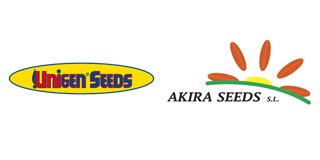
UNIGEN SEEDS SPAIN
Biobased bag, the best option compared to LDPE bags, for plum long therm packaging
Postharvest technologies as the lowering of the storage temperature, the modifying of air composition and the packaging are needed to preserve the quality of plums at optimum levels during transportation and marketing. In this work, we determined the effects of three different box bags (75 cm x 110 cm): F1 (Mater Bi, 30 ?m), F2 (LLDPE, lineal low density poliethylene, 30 ?m), F3 treatment (LDPE, low density poliethylene, 30 ?m), on quality of Prunus salicina (Lindell) cv. Angeleno subjected to the storage conditions as in long-range international
20 November, 2020
Postharvest technologies as the lowering of the storage temperature, the modifying of air composition and the packaging are needed to preserve the quality of plums at optimum levels during transportation and marketing. In this work, we determined the effects of three different box bags (75 cm x 110 cm): F1 (Mater Bi, 30 ?m), F2 (LLDPE, lineal low density poliethylene, 30 ?m), F3 treatment (LDPE, low density poliethylene, 30 ?m), on quality of Prunus salicina (Lindell) cv. Angeleno subjected to the storage conditions as in long-range international transport in order to find the optimum packaging conditions. Fresh plum fruits placed in a paper board box of approximately 20 kg and were wrapped with the bags. To simulate the transport conditions, plums were stored at 1 ?+/- 1?C with a relative humidity (RH) of 90% up to 35 days. The same packages were subjected to further storage for 7 days under simulated retail display conditions (20? +/- 1?C). Quality analysis were performed at 0 days and after 35 days, while visual analysis were performed at the end of storage. The fruits from each packages (30 fruits random /each treatments) were evaluated for quality parameters, O2 and CO2 gas evolution inside each packages, weight loss (%), pulp hardness (kg/cm2), soluble solid content (?Brix) and the titratable acidity (meq/l). The best performance were obtained with the biobased bag (F1 treatment) that maintained at 35 days a passive modified atmosphere packaging (MAP) conditions of 17% for O2 and 3.7% for CO2; in fact the fruits wrapped with this film have had a good answer to the change of the temperature during the storage maintaining the best qualitative traits of the plums. All fruits maintained a good state of hydratation showing weight losses less than 1%. Plums stored with the F1 treatment maintained the ?Brix values near to the harvest time. The F1 treatment showed also the best visual analysis at 20? +/- 1?C. Original title, complete list of authors, and sourcesPerformance of different box bags for MAP to preserve the quality of plums cv. Angeleno in the transport storage conditionsRosella Briano, V. Girgenti, N.R. Giuggioli, C. PeanoDepartment of Agricultural, Forest and Food Sciences (DISAFA), Universita degli Studi di Torino, Via Leonardo da Vinci 44, Grugliasco (TO) 10095, Piemonte, Italy V Postharvest Unlimited, ISHS International Conference, 10-13 June 2014, Cyprus, http://web.cut.ac.cy/postharvest/The picture is by expofrut.com.ar ? Providers of bags for long therm cherry transportDeccoPaclife Key wordsPoscosecha?? ?postcosecha?? ?postharvest?? ?na-oes?? ??? ??? ???????? ????? ??? ?post-r?colte?? ????? ?? ??????????? ??? ?na-oogst?? ?post-raccolta?? ?Obr?bka po?? ?p?s-colheita?? ????????????????? ?hasat sonras??? ??? ?Ernte?? ????????????????? ????? ????????????? ?postcollita?? ?poskliz?ov頠 ????? ??? ??? ??? ?nakon branja?? ?pozberov頠 ??? ?obdelovanje zemlje po?? ?post-colleita?? ?????? ??????? ?pascapanen?? ??il?onn postharvest?? ??????? ?p?c ra?as?? ?derliaus apdirbimas po?? ?lepas tuai?? ??? ?? ???????? ?post-recoltare?? ??????? ??????? ???????????????????? ?????????????? ?????????????????? ?sau thu ho?ch?? ?????????????????? ?zangemva kwenkathi yokuvunaCiruela?? ??? ?plum?? ?pruim?? ???????? ???? ?pruno?? ?prune?? ???????????? ??? ????? ??? ?prugna?? ??liwka?? ?ameixa?? ???????? ?erik?? ?????? ??? Pflaume?? ??? ??? ??? ??? ??? ??? ??? ??? ??? ??? ??? ??? ??? ??? ??? ??? ??? ??? ??? ??? ??? ??? ??? ??? ??? ??? ???? ?









